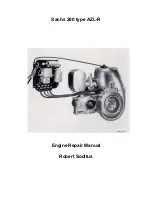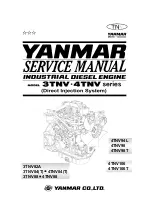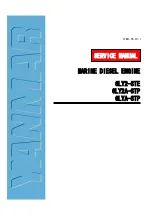
Page 2B-12
90-884294 OCTOBER 2001
Precautions
The following precautions must be observed when working on the alternator system. Fail-
ure to observe these precautions may result in serious damage to the alternator system.
1. Do not attempt to polarize the alternator.
2. Do not short across or ground any of the terminals on the alternator, except as specifi-
cally instructed.
3. Never disconnect the alternator output lead, regulator harness or battery cables when
the alternator is being driven by the engine.
4. Always remove NEGATIVE (–) battery cable from battery before working on alternator
system.
5. When installing battery, be sure to connect the NEGATIVE (–) (GROUNDED) battery
cable to NEGATIVE (–) battery terminal and the POSITIVE (+) battery cable to POSI-
TIVE (+) battery terminal.
6. When using a charger or booster battery, connect it in parallel with existing battery
(POSITIVE to POSITIVE; NEGATIVE to NEGATIVE).
Alternator Description
The alternator employs a rotor, which is supported in 2 end frames by ball bearings, and
is driven at 2.5 times engine speed. The rotor contains a field winding enclosed between
2 multiple-finger pole pieces. The ends of the field winding are connected to 2 brushes
which make continuous sliding contact with the slip rings. The current (flowing through
the field winding) creates a magnetic field that causes the adjacent fingers of the pole
pieces to become alternate north and south magnetic poles.
A 3-phase stator is mounted directly over the rotor pole pieces and between the 2 end
frames. It consists of 3 windings wound 120
°
electrically out-of-phase on the inside of a
laminated core. The windings are connected together on one end, while the other ends
are connected to a full-wave rectifier bridge.
The rectifier bridge contains 8 diodes which allows current to flow from ground, through
the stator and to the output terminal, but not in the opposite direction.
When current is supplied to the rotor field winding, and the rotor is turned, the movement
of the magnetic fields created induces an alternating current into the stator windings. The
rectifier bridge changes this alternating current to direct current which appears at the out-
put terminal. A diode trio is connected to the stator windings to supply current to the regu-
lator and the rotor field during operation.
Voltage output of the alternator is controlled by a transistorized voltage regulator that
senses the voltage at the battery and regulates the field current to maintain alternator volt-
age for properly charging the battery. Current output of the alternator does not require reg-
ulation, as maximum current output is self-limited by the design of the alternator. As long
as the voltage is regulated within the prescribed limits, the alternator cannot produce ex-
cessive current. A cutout relay in the voltage regulator also is not required, as the rectifier
diodes prevent the battery from discharging back through the stator.
A small amount of current is supplied by the excitation circuit in the regulator to the rotor
field to initially start the alternator charging. Once the alternator begins to produce output,
field current is supplied solely by the diode trio.
The alternator is equipped with 2 fans which induce air flow through the alternator to re-
move heat created by the rectifier and stator.
Summary of Contents for 225 EFI
Page 64: ...IGNITION Page 2A 8 90 884294 OCTOBER 2001 Coil Plate Assembly...
Page 66: ...IGNITION Page 2A 10 90 884294 OCTOBER 2001 Electrical Plate Assembly A...
Page 68: ...IGNITION Page 2A 12 90 884294 OCTOBER 2001 Electrical Plate Assembly A...
Page 100: ...CHARGING STARTING SYSTEM 90 884294 OCTOBER 2001 Page 2B 9 Notes...
Page 101: ...CHARGING STARTING SYSTEM Page 2B 10 90 884294 OCTOBER 2001 Flywheel Alternator...
Page 159: ...WIRING DIAGRAMS 90 884294 OCTOBER 2001 Page 2D 9 Notes...
Page 220: ...FUEL PUMP 90 884294 OCTOBER 2001 Page 3A 3 Notes...
Page 221: ...FUEL PUMP Page 3A 4 90 884294 OCTOBER 2001 Fuel Pump Assembly A...
Page 235: ...FUEL INJECTION Page 3B 6 90 884294 OCTOBER 2001 Fuel Management System...
Page 237: ...FUEL INJECTION Page 3B 8 90 884294 OCTOBER 2001 Fuel Management System...
Page 239: ...FUEL INJECTION Page 3B 10 90 884294 OCTOBER 2001 Vapor Separator Components...
Page 293: ...OIL INJECTION 90 884294 OCTOBER 2001 Page 3C 3 Notes...
Page 294: ...OIL INJECTION Page 3C 4 90 884294 OCTOBER 2001 Oil Injection Components...
Page 317: ...POWERHEAD 90 884294 OCTOBER 2001 Page 4A 5 Notes...
Page 385: ...POWERHEAD 90 884294 OCTOBER 2001 Page 4A 73 Notes...
Page 407: ...COOLING Page 4B 8 90 883728 JULY 2001 Notes...
Page 701: ...COLOR DIAGRAMS Page 8 2 90 884294 OCTOBER 2001 Notes...
Page 716: ...58847 1 2 3 4 5 6 7 8 9 10 11 12 13 14 15 16 17 18 19 20 21 22 23 24 25 26 27 28...
Page 719: ...7 7 14 59162 1 17 16 2 3 4 5 6 8 8 9 1 16 12 13 14 15 10 11 11 17 1 1...
















































